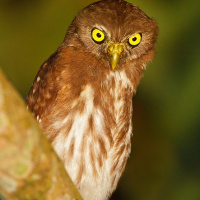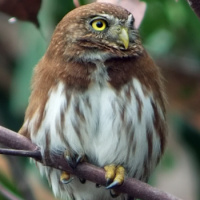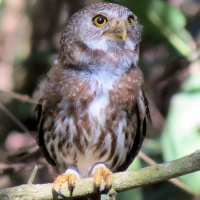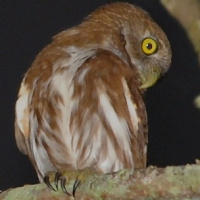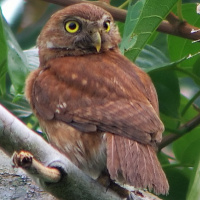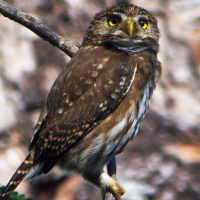Introduction
The Ferruginous Pygmy Owl is a very small Owl with no ear-tufts. Grey, brown and red morphs are known to exist, as well as intermediates.
Photo Gallery (6 pictures)
Sound Gallery
Information
Description: Brown Morph: The facial disc is pale ochre-brown with darker flecks. The eyebrows are whitish and the eyes yellow.
Cere and bill are greenish-yellow.
Upperparts are warm earth-brown with the crown having narrow pale buffish shaft-streaks, occasionally with some whitish dots, especially on the sides and rear
of the head. The nape has an occipital face of black false 'eye-spots' bordered whitish above and pale ochre below. The mantle and back are either plain or
irregularly spotted pale buff to whitish. Uppertail coverts have a rufous tint. The scapulars have pale buffish edges on the outer webs, and the wing-coverts
are spotted whitish or whitish-buff. Flight feathers are incompletely barred pale and dark. The tail is dark brown with 6-7 broken whitish bars.
Underparts are off-white, with the sides of the upper chest densely mottled brown with some paler flecks. The rest of the underparts are streaked brown. Tarsi
are feathered brown and pale buff. The toes are bristled and coloured pale yellow with orange-yellow soles. Claws are dark horn with blackish tips.
Red Morph: Upperparts are rusty-brown, more or less spotted buff. The crown has pale buffish shaft-steaks, sometimes appearing plain, but with small
buffish spots and very fine, pale shaft-streaks. The tail is rusty-brown with narrow dark brown bars - the dusky bars being narrower than the rusty ones.
Underparts are pale buffish with distinct, darker rusty-brown streaks.
Size: Length 17-20cm. Wing length 92-106mm. Weight 46-107g. Females are 15-30g heavier than males.
Habits: The Ferruginous Pygmy Owl is a partly diurnal bird, and may be seen in bright daylight on exposed perches, and may also sing by day. Principal activity is at dusk or around dawn, and they are sometimes vocally active on clear, calm nights. Roosts during the daytime within the shelter of foliage in trees or bushes, but always seems alert. When excited, this owl will cock its tail and flick it from side to side. Flight is undulating with rapid wingbeats and gliding.
Voice: The song of the male is a long series of equally spaced notes and the rate of three per second, with a 'bell-like' ringing character - poip-poip-poip-poip-poip... Phrases may comprise of 20-30 notes, and sometimes more if excited. Phrases are repeated after an interval of several seconds. The female has a similar but higher-pitched and less clear song. During courtship, male and female may be heard dueting, but the female soon utters just a high-pitched twitter in response to the male - trigigigick. When excited, utters several metallic chirrp notes at regular intervals of 2 per second. When advertising a potential nesting site, the male utters short sequences of high-pitched cricket-like trills - tsreep-tsreep-tsreep-tsreep-tsreep.
Hunting & Food: Feeds on insects, small birds and other small vertebrates such as mice. Birds up to the size of a dove have been recorded as prey. This owl has powerful talons and is able to catch prey larger then itself. Hunting is normally from a perch, but birds and insects may be caught among foliage with sudden dashing flights.
Breeding: Ferruginous Pygmy Owls are territorial for most of the year. The male advertises potential nesting sites by singing from a nearby
perch or by flying with a series of cricket-like chirps to the hole, entering and singing or chirping from the entrance, or from inside the cavity. Nests are
commonly abandoned woodpecker holes in trees, mud nests of other birds, burrows in banks or even holes in walls and opened nests of termites in trees. The nest
site is normally high up, but sometimes down low.
3-5 white eggs (average 29x23mm) are laid in a shallow depression scratched out by the adults at the bottom of the nest hole. Eggs are laid at two day
intervals, with incubation starting with the final egg and lasting 24-27 days. The female incubates alone while the male supplies the food.
Newly hatched chicks weigh about 4g and are initially fed only by the female, and later by both parents. They remain in the nest for about 4 weeks, and are able
to fly short distances when they leave. They are cared for by both parents for a further 2-3 weeks.
Habitat: Tropical and subtropical, mostly humid, primary or secondary forest with clearings, forest edges, riverine forest, pastureland with groups of trees and bushy areas, parks and large gardens with mature trees and thick bushes. This owl is normally found below below 1500m elevation. Prefers evergreen or semi-deciduous forest with undergrowth in the lowlands, and is common in the subtropical and tropical rainforest of eastern Brazil, eastern Paraguay and northeast Argentina where they mostly inhabit secondary forest with dense undergrowth.
Distribution: From northern South America east of the Andes, south through the Amazon to eastern Bolivia, Paraguay, eastern Brazil,
northeastern Argentina, Uruguay and central Argentina.
On this website, we have promoted the northern subspecies from central America to a full species -
Ridgway's Pygmy Owl Glaucidium ridgwayi.

Range of the Ferruginous Pygmy Owl Glaucidium brasilianum
Status: Locally common.
Original Description: Gmelin, Johann Freidrich. 1788. Systema Naturae (Syst. Nat.) 1: pt.1, p. 289.

